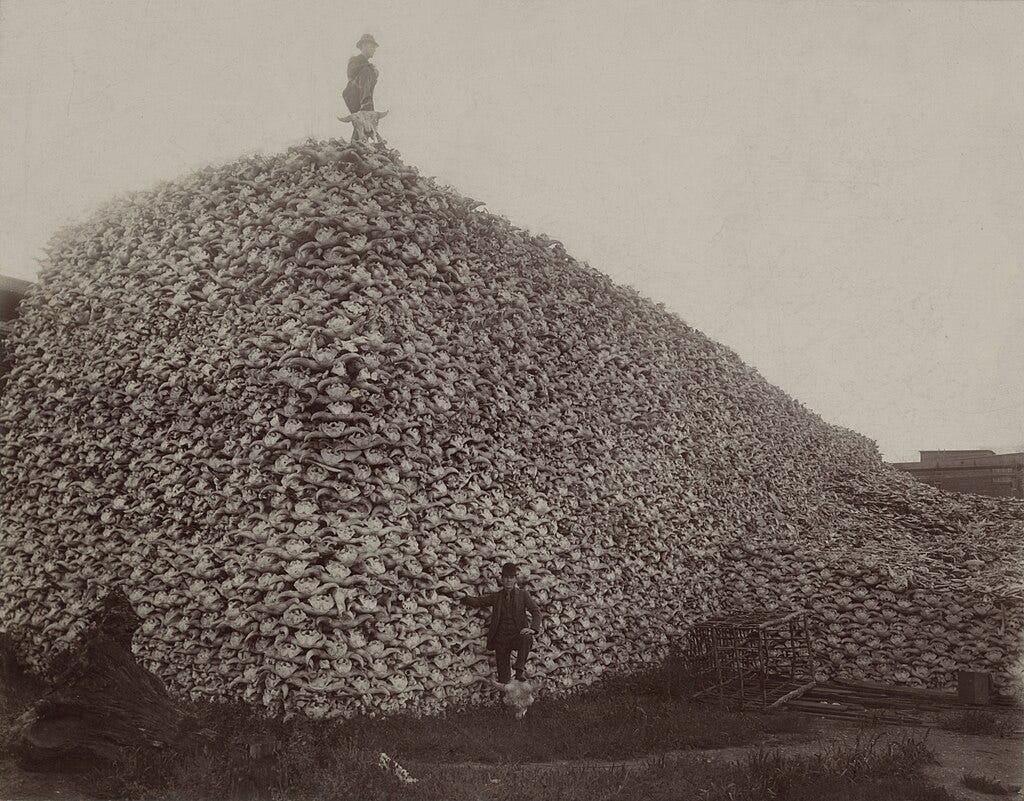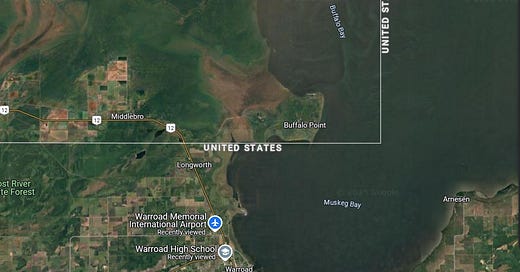I’ve always been curious as to why this place on the US-Canadian border was named Buffalo Point. On a satellite map, the shape of the peninsula sort of resembles a bison head. But would a place be named for its shape as seen from the sky before it had even been mapped or aerial photography invented? I don’t think so.
I know today there are no buffalo on Buffalo Point First Nation Reserve, but did the place get its name because there used to be?
When I was a kid on road trips up north to Warroad, my family often sang:
Oh give me a home,
where the buffalo roam
and the deer and the antelope play…1
I sang “Home on the range” in my 40s when driving my pickup truck to farmer’s market in upstate New York. My late husband, Sam Warren (1951-2009) raised deer, elk, and buffalo for breeding stock. Buffalo up close are magnificent creatures. They eat a lot of hay.
I’m not sure why I never questioned whether there had been buffalo at Buffalo Point until recently.
I had known that more than 60 million buffalo across the prairies were hunted and slaughtered to near extinction before 1900. Hides, meat, even skulls were sold.

Hunting buffalo was a deliberate tactic by the US government to eliminate a primary food source for Native American tribes, forcing them onto reservation lands and into dependency on government food rations.
During the 1800s when Chief Ay Ash Wash (1795-1899) and son Animikeese (1830-1905) lived at Buffalo Point, I wondered, were buffalo there?
I knew fur traders came here for the pelts of beaver, mink, fox, marten, and muskrat. How, I wondered, has the wildlife population in this area changed over time?
I knew who had the answers to my questions.
Gretchen Mehmel is the retired Manager of the Red Lake Wildlife Management Area. Gretchen is also a friend and for the past five years we have been in a book club together. Earlier this year (during hockey tournament season), she gave a half-hour presentation for “History on Tap” at the Lake of the Woods Brewery sponsored by the Warroad Heritage Center.
Spoiler alert: According to Gretchen, it seems likely there were buffalo in the 1700s at Buffalo Point. And elk.
Today there is a herd of elk to the west of Roseau in Kittson County which migrates back and forth between Minnesota and Manitoba.
More than 20 years ago, according to legend, a bull elk showed up north of Marvin Windows & Door. The bull lived there for six years before he crossed the Warroad River and moved east to the south end of the lake for another 14 or so years. Elk rarely live longer than 15 years in the wild. In March of 2023, according to the Twin Cities’ Pioneer Press, the “Warroad Elk” died, apparently of old age, near a farmer’s hay shed.
Moose, too, have lived for at least two centuries around Lake of the Woods.
Did you know the English word Moose comes from the Ojbway language?
I remember the one and only time I saw a moose. I must have been around 8 or 9 years old when I watched a moose trot across a field, cross Highway 313 and onto the lawn where my aunt and uncle lived. The moose walked right up the steps and rang the front door bell.
Nobody used the front door except the Avon Lady. Our laughter and the barking dog persuaded the moose to back down and away it went through the hedgerow. I haven’t seen either a moose or an Avon Lady since.
The wildlife in northwestern Minnesota and southeastern Manitoba on Lake of the Woods is one of many reasons this place feels like home — where the buffalo once roamed.
“Home on the Range,” American folk tune. Brewster M. Higley wrote the lyrics as a poem in 1873. Higley was a homesteader in Kansas. Today the folk tune is the state song of Kansas.






Every time I read something about buffalo, that image of the white men on that mountain of buffalo skulls seeps into my brain, and my heart hurts. Love Dr. Anton Treuer. I've seen a few moose in my time--how majestic.
Now I have "Home on the Range" in my head as my musical brain worm! Thanks for that, Jill. ;) It's interesting how we take place names at face value until something jogs our curiosity and we begin to wonder if they actually mean something. Good for you for digging into Buffalo Point and finding that it most likely really refers to bison. And thanks for that tiny glimpse into your past. Now I have a mental picture of you in your married-and-living-in-NY-state years, driving the truck to the Farmer's Market and singing "Home on the Range"--that's a sweet image!